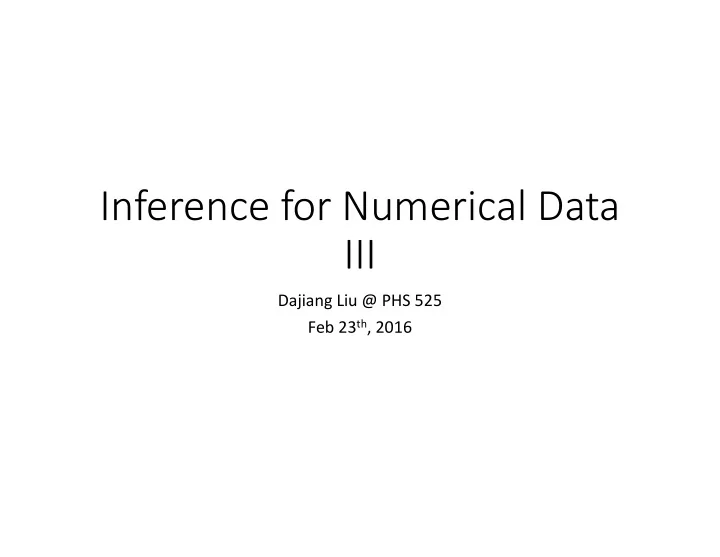

Inference for Numerical Data III Dajiang Liu @ PHS 525 Feb 23 th , 2016
Central Limit Theorem � is approximately normal. • The sample mean point estimates � �~� �, �� � � � • The approximation works when: • Sample size is “large” • A rule of thumb is sample size � ≥ 30 • The distribution should not be skewed (i.e. be symmetric) • There are no outliers • The approximation may not be good if any of the above 3 conditions are not met
Population Distribution does not need to be normal Sampling Distribution for Different Sample Sizes Sample mean is still normal when sample sizes are large enough
1
4.33 Answer • (a) The distribution is skewed toward smaller values and has several very large outliers • (b) As sample size gets larger, the distribution of the sample mean estimator behave more like normal distribution. Yet, there are still heavy upper tails, possibly due to the influence of the outliers with large values.
4.35 Answer • (1) -> (b) • (2) -> (a) • (3) -> (c) • The key is to examine the standard error. The sample mean from larger samples has the smallest standard errors.
One Sample Means with t-distribution • Central Limit Theorem requires large sample sizes • In large samples, sample mean estimate is more likely to be normally distributed • In large samples, the sample mean estimate tend to have smaller standard deviation Yet: • In many cases, large samples can be hard to attain • t-distribution can be a helpful alternative for small sample inference
The Normality Condition – Modified • Central limit theorem modified: • The sampling distribution for the mean is nearly normal when the sample observations are independent and come from a nearly normal distribution . • Important to note: • The CLT modified does not put constraint on the sample size • The CLT modified does require that population distribution is nearly normal • Original CLT does not require population distribution be normal • Even for sample sizes, CLT modified holds.
Degrees of Freedom (df) • Degrees of freedom measure the shape of the distribution • The larger the df, the more closely the t-distribution resembles the normal distribution
0 Tails are heavier
� Use t-distribution to Obtain Confidence Interval • Confidence intervals obtained using t-distribution can be more accurate • Procedures for obtaining t-distribution based confidence interval � • Obtain sample mean point estimate � • Obtain sample standard deviation � • Obtain standard error for the sample mean point estimate � = �/ � • �� � • Confidence interval is obtained by � − � ������ × �� � � ≤ � ≤ � � + � ������ × �� � � • � • � ������ is the critical t-value
Example: What is the normal and t- distribution based confidence interval??
� Example: What is the normal and t- distribution based 95%-confidence interval?? Answer: Answer: Answer: Answer: #.% � = �� � = 0.53 �& Normal confidence interval equals to (3.36,5.44) t confidence interval equals to (3.29,5.51)
Hypothesis Testing with t-Distribution • T statistic • For a sample of size � , � and standard deviation �� � � • Estimate sample mean � • To test the hypothesis ' ( : � = � ( v.s. ' ) : � > � ( • A t-statistic can be calculated � − � ( + = � � �� � The p-value can be assessed by Pr + ∗ > + , where + ∗ is a random variable with distribution � ������
Answer and R command: (a). pt(1.91,df=10,lower.tail=FALSE) [1] 0.04260244 (b). 2*pt(0.83,df=6,lower.tail=FALSE) [1] 0.4383084 (c). pt(-3.45,df=16,lower.tail=TRUE) [1] 0.001646786 (d). pt(2.13,df=28,lower.tail=FALSE) [1] 0.02104844
� Answer 5.19 • (a). ' ( : � = 8 v.s. ' ) : � < 8 0 .0%�1 (.#0 • (b). + = = − (.00 × 5 = −1.75 (.00/ #2 • (c). P-value 0.046 • (d). Reject the null hypothesis at 6 = 0.05 • (e). (7.47,7.99)
Recommend
More recommend